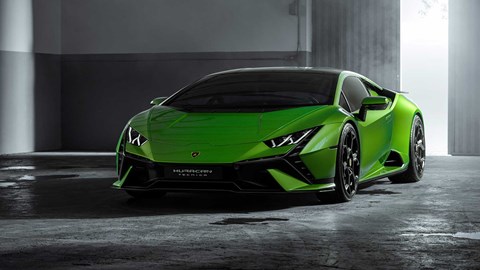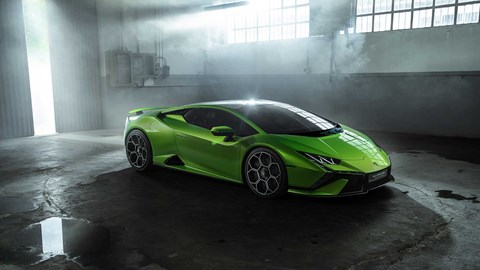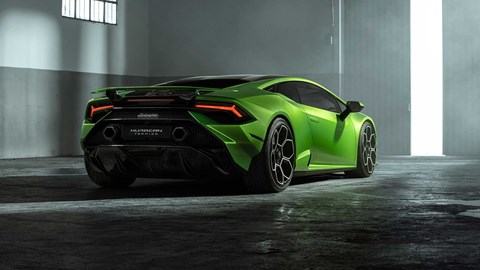► Another chapter in the Huracan story
► Biggest facelift yet for the V10 supercar
► Rear-drive only, 631bhp engine from STO
This is the Lamborghini Huracan Tecnica, the latest chapter in the model’s eight-year story, and the beginning of its final one. We’ve now driven it and you can read our Huracan Tecnica review here.
A newly facelifted and fettled version of Lamborghini’s baby V10 supercar, it’s available only with rear-wheel drive. It possesses a broader remit than the existing Huracan Evo RWD, which will continue on sale alongside.
The Tecnica is faster than the Evo RWD, more usable, more comfortable – yet also more track-capable, and intended to appeal to a wide range of customers from keen drivers keen to take their car on trackdays, to people who want to drive their car regularly on the road and in cities.

What’s with the name?
It’s called Tecnica because the car’s technical attributes have all advanced. Updated electronic brains to network its chassis and powertrain; more sophisticated aerodynamics; much-improved braking performance; and a more intricate, technical exterior design treatment courtesy of the most thorough facelift the Huracan’s yet had.
Or perhaps will have, given that CAR understands only one more variant will be released before the end of the Huracan’s life cycle. The Tecnica is not a limited edition model, but will be limited ultimately by time.
Where does it sit in the Huracan line-up?
It will sit as the median model in the line-up, below the all-out track-focused Huracan STO and alongside the all-wheel-drive Huracan Evo Spyder. Pricing is yet to be confirmed but expect a decent jump over the existing £165k Evo RWD.
This is the second big update for the Huracan, following its 2014 launch and 2019’s Huracan Evo.

What’s new?
Let’s start on the outside. Lamborghini’s sharp-suited head of design Mitja Borkert shows us around the Tecnica in the hangar building where Lamborghini prepares its SCV12 track cars, inside a smart, spacious area where the company displays special new cars to customers.
‘Usually a design update is just front and rear but this time, when you look at the car’s side view, you can see we have decided to work also on the side window graphic. We took this inspiration from the SCV12’s window graphic – it stretches the car’s length visually.’
At the front, too, a dark panel below the windscreen extends the screen’s shape lower into the car’s nose, changing its proportions at first glance. And at the nose, there is a thorough redesign of the front end, with much increased cooling for the brakes.

Those are now carbon ceramic as standard, to cope with the demands of track work. They’re housed within new wheels, with a hexagon-based design first seen on Lamborghini’s Vision Gran Turismo concept. ‘You should be able to tell it’s a Lamborghini wheel without seeing the badge,’ Borkert says.
At the rear, too, there’s a thorough redesign. The rear window is now a vertical element, the better to improve backward vision from the cockpit, and to let more light in. And the engine is now housed beneath a glass panel, the better to show it off.
The engine itself has had an upgrade too?
It’s effectively the same engine used in the hardcore Huracan STO, with an identical 631bhp output (around 30bhp more than the Huracan Evo RWD). Max torque is up at 6500rpm, so it’s worth using the revs for kinetic as well as aural reward.

‘We have optimised the exhaust system a little bit more so as to have the perfect emotions from the natural aspirated sound,’ Lamborghini’s new CTO Rouven Mohr, who has just joined us, adds.
To improve the Huracan’s touring ability, the engine and gearbox calibration has been made smoother than ever. And to improve its agility, it’s fitted with rear-wheel steering and the Lamborghini Dinamica Veicolo Integrata (LDVI) ‘brain’ system, networking all of the car’s dynamic systems together (from the rear-steer to the braking, torque vectoring, stability and traction control, electric power steering and everything else besides) to make it as agile and also as easy to control as possible.
‘The thing I’m most proud of is the easiness to drive,’ Mohr says. ‘Some years ago, if you would have thought about a 640-horsepower, mid-engine car you probably would be a little bit scared. With this car, you can believe me, on the track, it’s so predictable what the car does. I never drove a mid-engine car with this level of horsepower in such a playful way.’

What else is new?
Aerodynamic performance is significantly improved over the Huracan Evo, with a fixed rear wing offering a 35% increase in rear downforce, yet with a 20% reduction in drag. Aside from downforce, improved cooling and thermal management is a big part of the new bodywork’s story, aside from a style point of view.
The Tecnica has its own suspension setup different from other Huracans, in line with its remit to be more playful. The new electronics have enabled Lamborghini to set the Tecnica up to be more playful and less understeer-biased than the old RWD, while its softer suspension setup also puts it on less of a knife-edge than the STO.

Its remit is to be more fun to drive than the old RWD Huracan, and the 4WD Huracan Evo, but also easier to live with, less extreme (and less extremely expensive) than the STO.
The Tecnica goes on sale in summer 2022, with pricing to be confirmed. Watch this space for more details soon.